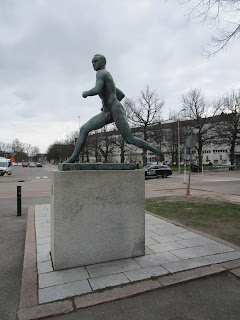.JPG) |
| The statue of Paavo Nurmi stands outside the Olympic Stadium in Helsinki. |
Only a limited amount of time for tourism today. Duty called. Work had to be done. Every so often there are days like that when you're self-employed. This was one.
I had a 24-hour tram pass so it was time to go off sightseeing.
This was the first sight I saw sightseeing.
This was a statue in a park I saw en route to my intended destination. The scuplture is "Ilmatar and the Scaup." You can clearly see Ilmatar. And that also must be the Scaup. Yes, I have no idea what "Ilmatar and the Scaup" is and whether this indeed shows an Ilmatar and a Scaup. I'm just pretending I know of what I am talking. But I had to guess, I would guess they are from mythology, but whose mythology I know not.
Also en route to my destination, I saw birds I had never seen before.
That is a Eurasian oystercatcher. I googled him. Very distinctive from the long orange bill and Clorox white breast. This next bird:
I am sure this is a goose of some sort, but, unlike the Eurasian oystercatcher above, I was unsuccessful in identifying which species of goose. But whatever species of goose this may be, he and his cohorts were hanging out at my first destination du jour.
Who is Sibelius?
Why he is only the most famous Finnish composer ever. You may not know the name, but you probably heard the music. At least one piece of music in particular: "Finlandia". This is the piece linked to a couple of pictures up.
.JPG)
Visiting the Jean Sibelius monument has been endorsed by other Helsinki tourists.
His monument is one of the major landmarks of the Helsinki tourism trail. This and the Lutheran Cathedral are probably the two sites depicted when someone wants to use a picture that denotes Helsinki, It's about three kilometers north of my hotel. Walkable, but I chose not to.
That is the view from behind.
This is a cool view from beneath:
I moved over a foot and the view from underneath got even cooler looking:
The monument is 600 steel pipes welded together. While it is supposed to be an abstract, it also kinda-sorta invokes an image of organ pipes, which is not really apropos as Sibelius did not compose organ music. The face of Sibelius was later added by the artist in response to critics, in order to make the Sibelius monument a little more Sibelius.
Portrait of a tourist posing at the Sibelius Monument:
The person who took my picture for me then recommended to me a nearby coffee shop, right on the water.
Cafe Regatta.
It was an excellent recommendation. First of all, there were two choices for regular black coffee: dark roast or light roast.
Finns love a light roast. Finns would be like all your friends from New England and New Jersey who rave about Dunkin Donuts coffee. Yes, the caffeine content is higher in lighter roasts as the roasting process breaks down a little of the caffeine. I am willing to sacrifice a little of the caffeine chemical for enhanced flavor. Give me a cup o' the dark, please.
And, to complete the "fika," I ordered a cinnamon bun. It was soft and warm. Like love is supposed to be. Not stale or dry at all. This was so good that, for a least that moment, I was not missing the cardamom buns of Stockholm.
Warmed up and fortified with caffeine and cinnamon, it was time to move on. But, first, let us check out the waterside.
Viewing stands:
I am guessing they do some sort of rowing or crew here, hence the viewing stands.
But I was here for an athlete in a different sport.
Paavo Nurmi. The greatest distance runner in his day. He medaled extensively at the Olympic games of 1920 (Antwerp), 1924 (Paris), and 1928 (Amsterdam). He would have medaled in 1932 Los Angeles Olympics but, controversially, he was banned for being "professional," as the Olympics were the personal playground of the wealthy Anglo-European elite. People who had to work for a living were not very welcome at the Olympics back then.
As you can see from this angle, in his statue, Mr. Nurmi is dressed not for running. He is dressed (undressed) for the sauna.
I guess this is supposed to harken back to the Olympics of Ancient Greece. Regardless, I was able to get a picture with Mr. Nurmi.
Back in my school days, I did a report for some social studies class on Finland. I remember that, in the report, I traced over pictures depicting things that represent Finland. The only thing I remember in the report is a tracing stating that a statue of Paavo Nurmi stands outside the Helsinki Olympic Stadium.
Yes, Helsinki has an Olympic Stadium.
As you might be able to see if you were to enlarge that picture of the Olympic tower next to the Olympic stadium, Helsinki hosted the summer olympics in 1952. Paavo Nurmi was the one chosen to light the Olympic flame for those games.
Mr. Nurmi has now been joined by a running companion: Lasse Viren. Mr. Viren won two gold medals in the 1972 Munich Olympics, in the 5000m and the 10,000m events. He repeated that double in the 1976 Montreal Olympics. Unlike Mr. Nurmi, Mr. Viren, as you can see, is dressed for running and not for the sauna.
Dramatically, in the 1972 Olympics, Viren not only gold-medaled in the 10,000m, he set a world record after he fell to the ground mid-race, when his legs became entangled with another runner. That's worth getting a statue for doing.
.JPG)



.JPG)



.JPG)











.JPG)





No comments:
Post a Comment